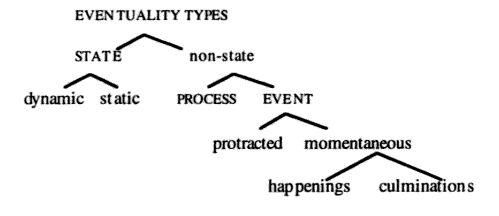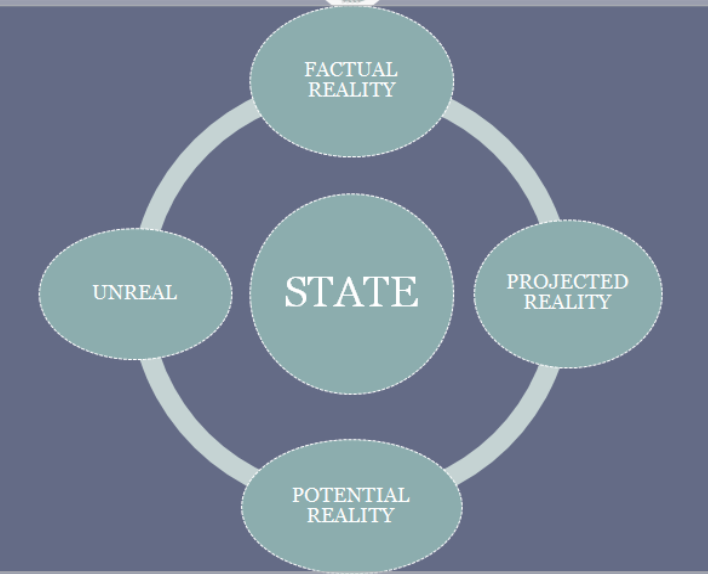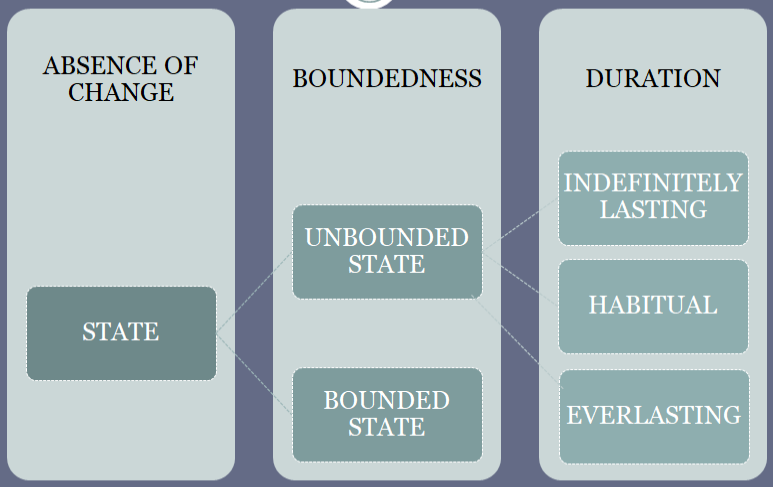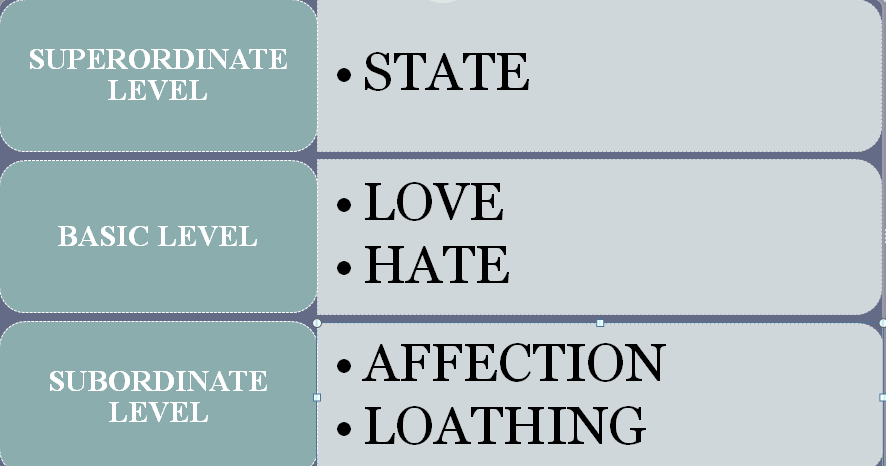Abstract
Under the Cognitive Linguistics framework the paper aims at revealing the significant role of the stative format in the system of linguistic knowledge representation. According to the cognitive theory of language as a unity of representative, communicative, and interpretive aspects, the stative format of linguistic knowledge is understood as a form of linguistic interpretation of knowledge about the world with a common conceptual basis of absence of change. The study focuses on ascribing conceptual and linguistic dominance in stative interpretation. On the conceptual level the stative dominance consists in the fundamental importance of stative concepts for human cognition and communication that provides realization of their dominant role in human conceptual system. Stative conceptualization on the basic level leads to forming such psychologically significant binary concepts, as HEALTH and ILLNESS etc. The super ordinate level is represented by STATE OF AFFAIRS concept which finds actualization in such conceptual and thematic domains as FACTUAL REALITY, PROJECTED REALITY and POTENTIAL REALITY. The subordinate level of stative conceptualization is formed by types and kinds of basic states. Its prototypical non-closed structure is formed by linguistic units performing interpretive stative function. Categorical analysis of linguistic stativity units results in revealing core and periphery areas on the basis of the following criteria: primary character of stative function performance, its predicative syntactic position, and its semantic correlation with the corresponding conceptual and thematic domain. Thus, we claim that the study of the cognitive space of stativity proves STATE to be a cognitive dominant of linguistic cognition.
Keywords: Category of linguistic stativitydominationlinguistic cognitionstatestative concept
Introduction
The overview of a large and growing research on stative forms in different languages shows inconsistency and lack of theoretical explanation of the principles the knowledge about the world is represented in the stative format. Though different aspects of this problem were discussed ( Barsalou, 2012; Boldyrev, 2014, 2016, 2018; Jackendoff, 1995; Michaelis, 2011; Pavlova, 2016, 2018), the systemic ascription of dominant principle realization was not taken yet.
To begin with, even ancient Greeks considered the category of state to be essential for human cognition and included it in the list of 10 significantly important categories. From that time on the notion of state was in the focus of research in philosophical, psychological, physiological and linguistic studies ( Lektorskiy, 2007; Prokhorov, Valiullina, Gabdreeva, Garifullina, & Mendelevich, 2011; Danilova & Krylova, 2005; Greimas & Fontanille, 2007). Among the theories pertaining for the present study it’s crucial to mention one within the Philosophy of Language approach. The study taken in the middle of the XX th century by one of the precursors of Cognitive Linguistics, Vendler ( 1957) results in a four-part classification which was a starting point for many other attempts to study different so called “types of situations” ( Kenny, 2003; Mourelatos, 1978) or “eventuality types” ( Bach, 1986) (Fig.

The most challenging area of this classification is the criteria for defining a state to be static or dynamic. The examples in Bach ( 1986) represent pure static situations with genuine states (e.g. “be in New York”, “own (a house)”, “love (one’s cat)”, “resemble (one’s uncle)”, “be tall”, “be intelligent”, “be sane”) and dynamic state situations (“sit”, “stand”, “lie”, “be drunk”, “be present”, “be sick”) which are very unstable, easy to be changed ( Bach, 1986), forming the transition area between state and non-state conceptualizations.
So, the paper aiming at revealing the pivotal role of state as a form of linguistic cognition firstly gives a brief overview of history of the problem pointing out the key theories, secondly highlights the data, research questions and methods of the study and finally provides important insights into grounding STATE dominant role.
Problem Statement
As the study taken under the Cognitive Linguistics (CL) framework, some cognitive English grammar assumptions should be pointed out. As it is generally known, CL posits that human thought is organized around two basic types of conceptual units: things and relations. As relations can’t be thought of without things, they manifest their dependency from things, both forming the conceptual core of a situation. According to Radden and Dirven ( 2007), things and relations can be conceptualized as existing in “factual reality”, “projected reality”, “potential reality” or as unreal (p. 173) (Fig.

Further typology of states is based on the boundedness as one of state-structuring conceptual characteristics. According to it, states can be viewed as inherently unbounded (lasting states) and implicitly bounded (temporary states). Depending on the specificity of duration as another state-structural characteristic, lasting states in their turn are viewed as indefinitely lasting, habitual and everlasting. As Radden & Dirven ( 2007) argue, “indefinitely lasting states are conditions that last for an indefinite time but may eventually cease to exist” (p. 191). So, indefinitely lasting states can be interpreted as tending to change characteristics, as human emotional states, perceptual states, mental states, states of being and possessing, etc., for example:
Another type of lasting states is habitual states which are defined as successions of indefinitely recurrent equivalent situations, for example:
In the English language habitual states are construed as if losing the sight of interruptions and are represented as forming a homogeneous lasting state. They can be expressed as present habits, customs, occupations or former and no longer existing, for example:
Sam
The Japanese
She
Mary
One more type of lasting states is everlasting states, their existence or truth is timeless and unchangeable. That is the reason for them not to be used in the past or future, the continuous aspect is also impossible for them. So, they interpret geographical locations, physical laws, definitions, eternal truths and proverbial truths, or generalizations that are believed to be true. For example:
All physical objects
Bodies not acted upon by a force
A circle
The appetite

As we mention, implicitly bounded, or temporary, states, are pointed out as a separate type because of interpreting situations as homogeneous absence of change but presupposing either the end of this state and beginning of the other, or an extremely unstable character of state. For example, indefinitely lasting states can be construed as temporary if interpret some human position in space, as in
Like some indefinitely lasting states, habitual states can last temporarily. Usually it is again the matter of our world knowledge. Speaking about sleep we know that as a human physiological state it can last long, but not indefinitely, so to enhance its present or past moment duration we may say
So, this briefly conveyed typology of states in English not only outlines the key stative conceptual characteristics but forms a basis for pointing out different aspects of state domination in thought and language.
Research Questions
The main research question of this study is:
What significantly important aspects do provide considering state as a dominant form of linguistic cognition?
Purpose of the Study
The present study aims at showing the outstanding role of state as a form of linguistic cognition revealing the dominant principle of stative concept organization and its verbal representation.
Research Methods
In order to reveal state domination in language and thought we use the conceptual analysis of stative forms. This analysis helps deciphering basic, superordinate and subordinate levels of stative concept. The categorical analysis of linguistic stativity is used to reveal its structural specificity.
Findings
It is common knowledge that our world is constantly changing, so, to have the chance to fix relations among things in general and conceptualize results of the changing a man has a cognitive ability “to stop the moving world” and interpret its characteristics statively with the help of language. As our previous studies argue, according to the Theory of Linguistic Interpretation, language is considered to be a system of interpretation of world and knowledge about the world (Boldyrev, 2014, 2016, 2018). Using computer metaphor, we can say that knowledge about the world is formatted by language aiming to construe different forms of linguistic cognition. Each form is a unique system of linguistic units with the hierarchy of conceptual characteristics which is a ground for corresponding linguistic category. STATE is viewed as one of such forms of linguistic cognition (Pavlova, 2016, 2018).
Its pivotal role for human cognition and communication can hardly be overestimated. It can be revealed both on the conceptual and linguistic levels. In the contemporary English language the system of stative forms is rather diverse, thus, the concept of state promises to have a complicated structure as an absence of change can be conveyed in different ways. It highlights the multidimensional structure of STATE with vast conceptual space of stativity. Such dimension as FEELINGS and EMOTIONS, PHYSICAL STATE, SOCIAL STATUS, and FINANCIAL STATE cover the most psychologically significant spheres of human life in general, and it also contributes to STATE dominant role in human conceptual system. The basic level of the concept of state is formed by binary conceptual structures revealing the dominant role of states, some of them are LOVE-HATE, HEALTH-ILLNESS, JOY-ANGER, etc. Fig.

On the linguistic level the stative concept is represented by the category of linguistic stativity which includes lexical and syntactical units with stative semantics. Taking into account a strong stativization power of linguistic cognition, the category of linguistic stativity has an open and continuously widening prototypical structure. Categorical analysis of linguistic stativity, formed by numerous linguistic units performing interpretive stative function, results in revealing core and periphery areas on the basis of the following criteria: primary character of stative function performance, its predicative syntactic position, and its semantic correlation with the corresponding conceptual and thematic domain. So, the core area is formed with
predicative adjectives (
prepositional phrases (
predicate nominals (
and the number of so-called stative verbs (
As a result of the analysis we argue that the core area of linguistic stativity represents indefinitely lasting states covering the semantic areas of the states of being and existing, psychological states, emotional states, mental states, perceptual states, states of possession and various relational states.
The nearest to the core periphery area represents temporary, habitual states and is formed with
verbs with state semantics which can be used in the progressive aspect: mental state verbs, positional verbs, bodily sensation verbs (
reified nouns (
verbs denoting successions of indefinitely recurrent equivalent situations (
The far periphery area represents everlasting states covering the semantics of physical laws, definitions, and eternal truths, generalizations which claim to be true and proverbial truths which are believed to be true. The far periphery area is formed with such syntactical units as
constructions with stative semantics (
simple sentences (
complex sentences (
Stative domination in language is also vividly identified in the creative linguistic mechanisms of stative interpretation of world knowledge. For example, linguistic interpretation of LOVE can be metaphorical, metonymical, ironical, etc., for example:
“He was only the second man she had kissed, and this instance was beyond the realm of what had preceded it, colored as it was by years of unrequited longing.
These examples of metaphoric, metonymic and simile interpretations of LOVE witnessed high figurative potential in representation of basic states and shed light on the general interpretive nature of stative form of linguistic cognition. This finding is considered as one of implications of stative dominance in thought and language.
Conclusion
The grounding of STATE to play a fairly pronounced role in human conceptual system became possible due to its viewing as an interpretive format of knowledge. Fixing the constantly moving world in language our linguistic cognition statively construes the knowledge about the world according to a set of conditions. As the study shows, these conditions are instantiated by a state-forming characteristic (absence of change) and state-structuring characteristics (boundedness and duration). Interpretation of knowledge about the world in the stative format results in the typology of states as implicitly bounded and inherently unbounded with the further types according to the kind of their duration. The psychological significance of basic stative concepts is one of leading aspects of state dominance on the conceptual level. Moreover, the non-closed prototypical structure of the category of linguistic stativity also contributes to pivotal role of stative form. This study bridges the gap between grammar and vocabulary in the investigation of dominant aspects in linguistic cognition organization.
Acknowledgments
The research is financially supported by the Russian Science Foundation grant (project 18-18-00267) at Derzhavin Tambov State University.
References
- Bach, E. (1986). The Algebra of Events. Linguistics and Philosophy 9, 5-16.
- Barsalou, L. W. (2012). The Human Conceptual System. In The Cambridge Handbook of Psycholinguistics (pp. 239 – 258). Cambridge: Cambridge University Press.
- Boldyrev, N. N. (2014). Interpretatsiya Mira i Znaniy o Mire v Yazyke [Interpretation of the World and World Knowledge in Language]. Kognitivnye Issledovaniya Yazyka [Cognitive Studies of Language], 19, 20-28.
- Boldyrev, N. N. (2016). Kognitivnye Skhemy Yazykovoy Interpretatsii [Cognitive Schemas of Linguistic Interpretation]. Voprosy Kognitivnoy Lingvistiki [Issues of Cognitive Linguistics], 4, 10-20.
- Boldyrev, N. N. (2018). Jazyk i Sistema Znanij. Kognitivnaja Teorija Yazyka [Language and the System of Knowledge. A Cognitive Theory of Language]. Moscow: LRC Publishing House.
- Danilova, N. N., & Krylova, A. L. (2005). Fiziologiya vysshey nervnoy deyatel'nosti [The Physiology of the Higher Nervous System]. Rostov-on-Don: Feniks.
- Greimas, A., & Fontanille, J. (2007). Semiotika strastey. Ot sostoyaniya veshchey k sostoyaniyu dushi [The Semiotics of Passions. From the State of Things to the State of a Soul]. Moscow: LKI Publishing House.
- Jackendoff, R. (1995). Semantics and Cognition. Cambridge, Mas.: The MIT Press.
- Kenny, A. (2003). Action, Emotion and Will. London: Routledge.
- Michaelis, L. A. (2011). Stative by Construction. Linguistics, 49(6), 1359-1399.
- Mourelatos, A. (1978). Events, Processes and States. Linguistics and Philosophy, 2, 415-434.
- Moyes, J. (2007). Silver Bay. London: Hodder & Stoughton.
- Moyes, J. (2010). The Last Letter from Your Lover. The United States of America: Viking Penguin, a member of Penguin Group (USA) Inc.
- Moyes, J. (2012). Me Before You. London: Penguin Books.
- Moyes, J. (2014). The Peacock Emporium. London: Hodder & Stoughton.
- Pavlova, A. V. (2016). Sostoyanie kak Format Yazykovogo Znaniya (na Materiale Sovremennogo Angliyskogo Yazyka) [State as a Linguistic Knowledge Format (Based on Modern English Language)]. Voprosy Kognitivnoy Lingvistiki [Issues of Cognitive Linguistics], 3, 96-102.
- Pavlova, A. V. (2018). Stativization as a Cognitive and Linguistic Mechanism of Stative Interpretation. The European Proceedings of Social & Behavioural Sciences: Proceedings of the International Conference "Word, Utterance, Text: Cognitive, Pragmatic and Cultural Aspects", XXXIX, 783-790.
- Lektorskiy, V. A. (2007). Poznaniye, Ponimanie, Konstruirovanie [Cognition, Understanding, Construing]. Moscow: the Institute of Philosophy of Russian Academy of Sciences.
- Prokhorov, A. O., Valiullina, M. E., Gabdreeva, G. S., Garifullina, M. M., & Mendelevich, V. D. (2011). Psikhologiya Sostoyaniy [The Psychology of States]. Moscow: Kogito-Center. 624 p.
- Radden, G., & Dirven, R. (2007). Cognitive English Grammar. Amsterdam/Philadelphia: John Benjamins Publishing Company.
- Vendler, Z. (1957). Verbs and Times. The Philosophical Review, 66, 143-160.
Copyright information

This work is licensed under a Creative Commons Attribution-NonCommercial-NoDerivatives 4.0 International License.
About this article
Publication Date
20 April 2020
Article Doi
eBook ISBN
978-1-80296-082-2
Publisher
European Publisher
Volume
83
Print ISBN (optional)
-
Edition Number
1st Edition
Pages
1-787
Subjects
Discourse analysis, translation, linguistics, interpretation, cognition, cognitive psychology
Cite this article as:
Boldyrev, N. N., & Pavlova, A. V. (2020). State As A Cognitive Dominant Of Linguistic Cognition. In A. Pavlova (Ed.), Philological Readings, vol 83. European Proceedings of Social and Behavioural Sciences (pp. 69-76). European Publisher. https://doi.org/10.15405/epsbs.2020.04.02.9
